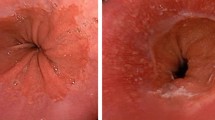Abstract
Background and Aim
Upper gastrointestinal (UGI) symptoms are common; however, the role of Helicobacter pylori and gastric corpus atrophy in the generation of these symptoms is controversial. The aim of this study was to determine the risk factors for UGI symptoms in adults in an endemic area of H. pylori infection.
Methods
Korean adults who completed questionnaires on the day of serum anti-H. pylori IgG and pepsinogen (PG) assays before UGI endoscopy were included. Gastric corpus atrophy was based on the criteria of a serum PG I/II ratio <3.0 and a PG I <70 ng/ml.
Results
Of the 2275 included subjects, 723 (31.8%) had at least one UGI symptom. A total of 374 (16.4%) subjects had multiple symptoms without significant correlations between the symptoms (λ < 0.2). The H. pylori serology assay was positive in 1382 (60.7%) subjects, and gastric corpus atrophy was present in 291 (12.8%). Neither H. pylori seropositivity (p = 0.077) nor gastric corpus atrophy (p = 0.138) was related to the presence of UGI symptoms. Female gender and smoking were independent risk factors for heartburn and upper abdominal pain (all p < 0.001). Furthermore, female gender was the only independent risk factor for multiple UGI symptoms (p < 0.001), globus sensation (p < 0.001), early satiety (p < 0.001), epigastric soreness (p = 0.001), and chest discomfort (p = 0.003).
Conclusions
In an H. pylori seroprevalent population, female gender is the most common risk factor followed by smoking for UGI symptom generation. Neither H. pylori seropositivity nor gastric corpus atrophy is an independent risk factor for UGI symptom generation.

Similar content being viewed by others
References
Ford AC, Marwaha A, Sood R, Moayyedi P. Global prevalence of, and risk factors for, uninvestigated dyspepsia: a meta-analysis. Gut. 2015;64:1049–1057.
Fang YJ, Liou JM, Chen CC, et al. Distinct aetiopathogenesis in subgroups of functional dyspepsia according to the Rome III criteria. Gut. 2015;64:1517–1528.
Lee SP, Sung IK, Kim JH, Lee SY, Park HS, Shim CS. The effect of emotional stress and depression on the prevalence of digestive diseases. J Neurogastroenterol Motil. 2015;21:273–282.
Tahara T, Arisawa T, Shibata T, et al. Association of endoscopic appearances with dyspeptic symptoms. J Gastroenterol. 2008;43:208–215.
Iwai W, Abe Y, Iijima K, et al. Gastric hypochlorhydria is associated with an exacerbation of dyspeptic symptoms in female patients. J Gastroenterol. 2013;48:214–221.
Wei Z, Ying L, Wen G, Mengnan Z, Yali Z. Rome III criteria cannot distinguish patients with chronic gastritis from those functional dyspepsia patients. Helicobacter. 2014;19:124–128.
D’Elios MM, Czinn SJ. Immunity, inflammation, and vaccines for Helicobacter pylori. Helicobacter. 2014;19:19–26.
Liu Y, Vosmaer GD, Tytgat GN, Xiao SD, Ten Kate FJ. Gastrin (G) cells and somatostatin (D) cells in patients with dyspeptic symptoms: Helicobacter pylori associated and non-associated gastritis. J Clin Pathol. 2005;58:927–931.
Lee SY. Endoscopic gastritis, serum pepsinogen assay, and Helicobacter pylori infection. Korean J Intern Med. 2016;31:835–844.
Iijima K, Sekine H, Koike T, Imatani A, Ohara S, Shimosegawa T. Serum pepsinogen concentrations as a measure of gastric acid secretion in Helicobacter pylori-negative and -positive Japanese subjects. J Gastroenterol. 2005;40:938–944.
Mizuno S, Miki I, Ishida T, et al. Prescreening of a high-risk group for gastric cancer by serologically determined Helicobacter pylori infection and atrophic gastritis. Dig Dis Sci. 2010;55:3132–3137. doi:10.1007/s10620-010-1154-0.
Eshmuratov A, Nah JC, Kim N, et al. The correlation of endoscopic and histological diagnosis of gastric atrophy. Dig Dis Sci. 2010;55:1364–1375. doi:10.1007/s10620-009-0891-4.
Choi HS, Lee SY, Kim JH, et al. Combining the serum pepsinogen level and Helicobacter pylori antibody test for predicting the histology of gastric neoplasm. J Dig Dis. 2014;15:293–298.
Kim JH, Kim HY, Kim NY, et al. Seroepidemiological study of Helicobacter pylori infection in asymptomatic people in South Korea. J Gastroenterol Hepatol. 2001;16:969–975.
Sharma P, Vakil N. Review article: Helicobacter pylori and reflux disease. Aliment Pharmacol Ther. 2003;17:297–305.
Konturek PC, Konturek SJ, Sito E, et al. Luminal Nalpha-methyl histamine stimulates gastric acid secretion in duodenal ulcer patients via releasing gastrin. Eur J Pharmacol. 2001;412:181–185.
Kawakubo H, Tanaka Y, Tsuruoka N, et al. Upper gastrointestinal symptoms are more frequent in female than male young healthy Japanese volunteers as evaluated by questionnaire. J Neurogastroenterol Motil. 2016;22:248–253.
Mirbagheri SS, Mirbagheri SA, Nabavizadeh B, et al. Impact of microscopic duodenitis on symptomatic response to Helicobacter pylori eradication in functional dyspepsia. Dig Dis Sci. 2015;60:163–167. doi:10.1007/s10620-014-3285-1.
Miwa H, Hirai S, Nagahara A, et al. Cure of Helicobacter pylori infection does not improve symptoms in non-ulcer dyspepsia patients—a double-blind placebo-controlled study. Aliment Pharmacol Ther. 2000;14:317–324.
Bode G, Brenner H, Adler G, Rothenbacher D. Dyspeptic symptoms in middle-aged to old adults: the role of Helicobacter pylori infection, and various demographic and lifestyle factors. J Intern Med. 2002;252:41–47.
Thomas GA, Rhodes J, Ingram JR. Mechanisms of disease: nicotine—a review of its actions in the context of gastrointestinal disease. Nat Clin Pract Gastroenterol Hepatol. 2005;2:536–544.
Fujiwara Y, Kubo M, Kohata Y, et al. Cigarette smoking and its association with overlapping gastroesophageal reflux disease, functional dyspepsia, or irritable bowel syndrome. Intern Med. 2011;50:2443–2447.
Matsuzaki J, Suzuki H, Kobayakawa M, et al. Association of visceral fat area, smoking, and alcohol consumption with reflux esophagitis and Barrett’s esophagus in Japan. PLoS One. 2015;10:e0133865.
Yap PR, Goh KL. Non-steroidal anti-inflammatory drugs (NSAIDs) induced dyspepsia. Curr Pharm Des. 2015;21:5073–5081.
Acknowledgments
This study was supported by Konkuk University in 2015.
Author information
Authors and Affiliations
Corresponding author
Ethics declarations
Conflict of interest
None.
Electronic supplementary material
Below is the link to the electronic supplementary material.
Rights and permissions
About this article
Cite this article
Lee, S.P., Lee, SY., Kim, J.H. et al. Factors Related to Upper Gastrointestinal Symptom Generation in 2275 Helicobacter pylori Seroprevalent Adults. Dig Dis Sci 62, 1561–1570 (2017). https://doi.org/10.1007/s10620-017-4529-7
Received:
Accepted:
Published:
Issue Date:
DOI: https://doi.org/10.1007/s10620-017-4529-7



